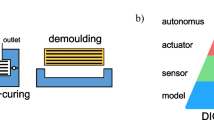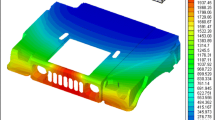Abstract
Elium® resin is nowadays actively investigated to leverage its recycling ability. Thus, multiple polymerization modeling are developed and used. In this work, we investigate the polymerization of Elium®/Carbon fiber composite in a cylindrical deposition, followed by an in-oven heating. The model parameters are optimized using an active-set algorithm to match the experimental heating profiles. Moreover, the simulation efforts are coupled to an artificial intelligence modeling of the discrepancies. For instance, a surrogate model using convolution recurrent neural network is trained to reproduce the error of the simulation. Later, a digital twin of the process is built by coupling the simulation and the machine learning algorithm. The obtained results show a good match of the experimental results even on the testing sets, never used during the training of the surrogate model. Finally, the digital twin results are post-processes to investigate the resin polymerization through the thickness of the part.










Similar content being viewed by others
References
Kumar HP, Xavior MA (2021) Composite materials production for automobile applications. In: Brabazon D (ed) Encyclopedia of materials: composites. https://doi.org/10.1016/B978-0-12-803581-8.11894-6https://doi.org/10.1016/B978-0-12-803581-8.11894-6 . https://www.sciencedirect.com/science/article/pii/B9780128035818118946https://www.sciencedirect.com/science/article/pii/B9780128035818118946 . Elsevier, Oxford, pp 640–651
Perez M, Barasinski A, Courtemanche B, Ghnatios C, Chinesta F (2018) Sensitivity thermal analysis in the laser assisted tape-placement process. Aims Mater Sci 5(6):1053–1072. https://doi.org/10.3934/matersci.2018.6.1053https://doi.org/10.3934/matersci.2018.6.1053
Stewart R (2011) Thermoplastic composites—recyclable and fast to process. Reinf Plast 55 (3):22–28. https://doi.org/10.1016/S0034-3617(11)70073-Xhttps://doi.org/10.1016/S0034-3617(11)70073-X. https://www.sciencedirect.com/science/article/pii/S003436171170073Xhttps://www.sciencedirect.com/science/article/pii/S003436171170073X
Bernatas R, Dagreou S, Despax-Ferreres A, Barasinski A (2021) Recycling of fiber reinforced composites with a focus on thermoplastic composites. Clean Eng Technol 5:100272
Jones R (1999) Mechanics of composite materials, 2nd edn.Taylor and Francis group
Bur N, Joyot P, Ghnatios C, Villon P, Cueto E, Chinesta F (2016) On the use of model order reduction for simulating automated fibre placement processes. Adv Model Simul Eng Sci 3:1–18. https://doi.org/10.1186/s40323-016-0056-x
Strau S, Wilhelm F (2020) Development of a flexible injection and impregnation chamber for pultrusion of high reactive resins. Procedia Manuf 47:956–961. 23rd International conference on material forming. https://doi.org/10.1016/j.promfg.2020.04.294https://doi.org/10.1016/j.promfg.2020.04.294. https://www.sciencedirect.com/science/article/pii/S2351978920313603https://www.sciencedirect.com/science/article/pii/S2351978920313603
Ghnatios C, Simacek P, Chinesta F, Advani S (2020) A non-local void dynamics modeling and simulation using the proper generalized decomposition. Int J Mater Form 13:533–546
Castéran F, Ibanez R, Argerich C, Delage K, Chinesta F, Cassagnau P (2020) Application of machine learning tools for the improvement of reactive extrusion simulation. Macromol Mater Eng 12:2000375
Adel A, Salah K (2016) Model order reduction using artificial neural networks. In: 2016 IEEE International conference on electronics, circuits and systems (ICECS). IEEE, pp 89–92
de Weg BV, Greve L, Andres M, Eller T, Rosic B (2021) Neural network-based surrogate model for a bifurcating structural fracture response. Eng Fract Mech 241:107424
Hage R -M, Hage I, Ghnatios C, Jawahir I, Hamade R (2019) Optimized tabu search estimation of wear characteristics and cutting forces in compact core drilling of basalt rock using pcd tool inserts. Comput Ind Eng 136(10):477–493
Ghnatios C, Hage R -M, Hage I (2019) An efficient tabu-search optimized regression for data-driven modeling. C R Mec 347(11):806–816
Xu R, Wang N, Zhang D Solution of diffusivity equations with local sources/sinks and surrogate modeling using weak form theory-guided neural network. Adv Water Resour. In press. https://doi.org/10.1016/j.advwatres.2021.103941
Ibanez R, Casteran F, Argerich C, Ghnatios C, Hascoet N, Ammar A, Cassagnau P, Chinesta F (2020) On the data-driven modeling of reactive extrusion. Fluids 94(5):1–23. https://doi.org/10.3390/fluids5020094https://doi.org/10.3390/fluids5020094
González D, Chinesta F, Cueto E (2019) Thermodynamically consistent data-driven computational mechanics. Contin Mech Thermodyn 31:239–253
Ghnatios C, Alfaro I, Gonzalez D, Chinesta F, Cueto E (2019) Data-driven generic modeling of poroviscoelastic materials. Entropy 21(12):1165
Gonzalez D, Chinesta F, Cueto E (2019) Thermodynamically consistent data-driven computational mechanics. Contin Mech Thermodyn 31(1):239–253
Soize C (2000) A nonparametric model of random uncertainties for reduced matrix models in structural dynamics. Probabilistic Eng Mech 15(3):277–294
Soize C, Farhat C (2016) A nonparametric probabilistic approach for quantifying uncertainties in low- and high-dimensional nonlinear models. Int J Numer Methods Eng 109:837–888. https://doi.org/10.1002/nme.5312https://doi.org/10.1002/nme.5312
Farhat C, Bos A, Avery P, Soize C (2017) Modeling and quantification of model-form uncertainties in eigenvalue computations using a stochastic reduced model. Am Inst Aeronaut Astronaut J 56(3):1–22
Soize C, Farhat C (2019) Probabilistic learning for modeling and quantifying model-form uncertainties in nonlinear computational mechanics. Int J Numer Methods Eng 117:819–843. https://doi.org/10.1002/nme.5980
Chinesta F, Cueto E, Abisset-Chavan E, Duval J -L, Khaldi F (2020) Virtual, digital and hybrid twins: a new paradigm in data-based engineering and engineered data. Arch Comput Methods Eng 27:105–134
Ghnatios C A hybrid modeling combining the proper generalized decomposition (pgd) approach to data-driven model learners, with application to non-linear biphasic materials. C R Méc. In Press
Ghnatios C, Barasinski A (2021) A nonparametric probabilistic method to enhance pgd solutions with data-driven approach, application to the automated tape placement process. Adv Model Simul Eng Sci 8(1):20. https://doi.org/10.1186/s40323-021-00205-5
Gayot S, Bailly C, Pardoen T, Gérard P, Loock FV (2020) Processing maps based on polymerization modelling of thick methacrylic laminates. Mater Des 196:109170
Askeland D, Fulay P, Wright W (2020) The science and engineering of materials, 6th edn. Cengage Learning
Nocedal J, Wright SJ (1999) Numerical optimization. Springer
Allery C, Beghein C, Hamdouni A (2005) Applying proper orthogonal decomposition to the computation of particle dispersion in a two-dimensional ventilated cavity. Commun Nonlinear Sci Numer Simul 10:907–920
Liberge E, Hamdouni A (2010) Reduced order modelling method via proper orthogonal decomposition (pod) for flow arround and oscillating cylinder. J Fluids Struct 26:292–311
Ryckelynck D (2005) A priori hyper-reduction method: an adaptive approach. J Comput Phys 202:346–366
Bernardi C, Maday Y (1997) Spectral methods. In: Handbook of numerical analysis, vol 5, pp 209–485
Reddy J (2006) An introduction to the finite element method, 3rd edn. Mc Graw Hill
Klambauer G, Unterthiner T, Mayr A (2017) Self-normalizing neural networks. In: 31st Conference on neural information processing systems (NIPS 2017), Long Beach, pp 1–102
Acknowledgements
This work was proposed in the framework of the E2S UPPA AWESOME Chair. The authors would like to thank the Chair partners (E2S UPPA, ARKEMA and CANOE) for funding their work.
Author information
Authors and Affiliations
Corresponding author
Ethics declarations
Conflict of Interests
The authors declare that they have no conflict of interest.
Additional information
Publisher’s note
Springer Nature remains neutral with regard to jurisdictional claims in published maps and institutional affiliations.
Appendix: Polymerization material properties
Appendix: Polymerization material properties
In this section we review the used properties of the polymerized composite material, as illustrated in Table 5. For detailed explanation on the used polymerization and heat generation model please refer to reference [26], Appendix A.
Rights and permissions
Springer Nature or its licensor (e.g. a society or other partner) holds exclusive rights to this article under a publishing agreement with the author(s) or other rightsholder(s); author self-archiving of the accepted manuscript version of this article is solely governed by the terms of such publishing agreement and applicable law.
About this article
Cite this article
Ghnatios, C., Gérard, P. & Barasinski, A. An advanced resin reaction modeling using data-driven and digital twin techniques. Int J Mater Form 16, 5 (2023). https://doi.org/10.1007/s12289-022-01725-0
Received:
Accepted:
Published:
DOI: https://doi.org/10.1007/s12289-022-01725-0




